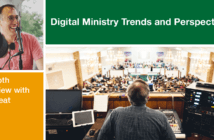Lovett H. Weems, Jr., says that giving at year-end represents an increasing portion of total giving in many churches. Recognizing the many different circumstances that may motivate people’s desire to give in December, he suggests strategies to maximize giving at the end of the year.
Have you observed that more of your church giving comes in December than in any other month of the year? This is one reason churches are often frustrated when they track their giving by dividing the budget by 12 months or 52 weeks. People don’t give so neatly. And increasingly, a greater portion of the giving comes at or near the end of the year. (For a better way to track giving, check out the Lewis Center’s Congregational Giving Profile resource.)
Many churches design appeals that connect with people’s particular motivation to give at year’s end. It may be a request to consider a special year-end or second-mile gift, or a mission-related need.
The end of the year is a time when many people are motivated to give. But it is also a time when giving practices are shaped by any number of different circumstances. Many people will need to catch up on their giving before December 31, while others might want to offer a “second-mile gift.” Even those who don’t typically give may be moved to support a missional purpose at Christmas time.
Some givers are waiting to know the size of their year-end bonus before completing their tithe. And if they’ve had a particularly good year, they may be open to additional giving. Others may want to donate appreciated assets or prepay gifts for the coming year before the end of the tax year. Add to this mix that many people travel over the holidays, and you can see the importance of being sensitive to different situations as you seek to maximize generosity at the end of the year!
Here are some possibilities to consider as you plan communications and appeals related to year-end giving:
1. Let people know where their giving stands.
Since many churches mail out giving records quarterly, members may not receive a report when they most need it — in the last month of the year. People often welcome a reminder of the outstanding balance on their annual commitment. So whatever your schedule for mailing statements, make sure there is a final reminder as early as possible in December that covers giving through November. If people view their giving records online, rather than receiving a printed statement, you’ll want to remind them to check their records.
3. Remind people of different ways to make their gifts.
With busy holiday schedules and travel, many givers will appreciate the possibility of online giving, automated payments, or using bill pay systems through their banks. The end of the year is a good time to encourage electronic giving — especially since it may establish a pattern that will continue into the coming year.
3. Provide Special Year-end Giving Opportunities.
Many churches design appeals that connect with people’s particular motivation to give at year’s end. It may be a request to consider a special year-end or second-mile gift, or a contribution to help the church close out its budget year in the black. And at Christmas time, many congregations will lift up a mission-related need as a way of inspiring generosity, especially among those who aren’t regularly in church at other times of the year.
4. Remind people of the good their giving does.
Remember that people are not giving to the church but through the church to accomplish God’s work. Your church is always a means and not the end. Since people tend to be particularly motivated to give during the holiday season, give them a reason to be generous not just to friends and family, but to God’s mission through the church.
5. Watch your language.
Church newsletters and bulletins are notorious for announcements about year-end giving that seem more for the benefit of church staff than the donors. They often begin with when the offices will be closed, followed by deadlines and restrictions on what gifts can count in what year. Why not begin from the donor’s perspective and not the receiver’s? Resist giving the impression that the church is doing people a favor by taking their money during the holidays.
Now is a good time to look ahead to what practices might enhance giving at the end of the year. Conversations with your finance team and other wise church leaders can be helpful in discerning what approaches best fit your context and the circumstances of your givers.
Related Resources:
- 50 Ways to Encourage Faithful Giving, a free resource from the Lewis Center
- Why Giving Matters and Clues for Improving It, a free video resource
- Congregational Giving Profile Video Tool Kit






